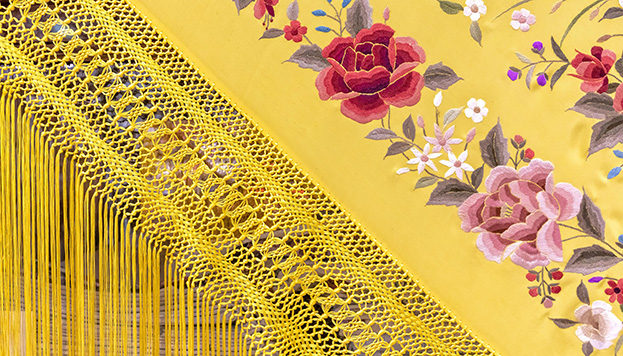
Borca. © Álvaro López del Cerro.
Despite the origins of this garment being traced to the Far East, the Manila shawl is one of the capital’s most representative items of clothing. Seen draped around the shoulders of all traditionally dressed chulapas at the city’s verbena festivities, the shawl forms part of the city’s history. Purchasing one is the perfect way to flaunt your visit to the capital.
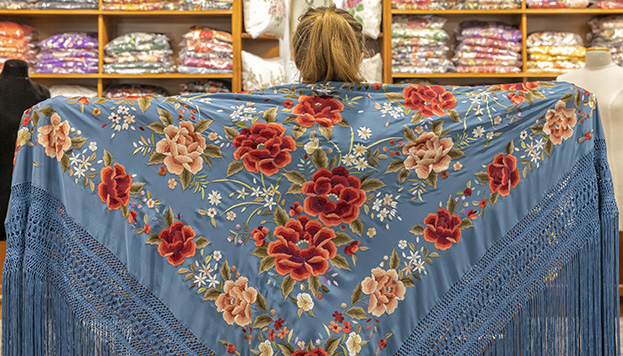
Borca. © Álvaro López del Cerro.
La verbena de la Paloma premiered on 17 February 1894 at Madrid’s Teatro de Apolo. The zarzuela—set in Madrid with libretto by Ricardo de la Vega and music by Tomás Bretón—is one of the most famous productions of the génerico chico genre. The story takes place during the city’s summer festivities in which chulapos like Julián and chulapas like Susana turn out in their finest traditional garb. He sings to her: Where are you going in your Manila shawl? Where are you going in your crêpe de chine dress? And she replies: “To impress, to see the verbena and then to go to bed.” Indeed, the garment she is wearing in this famous scene was—and still is—designed to turn heads. It was Susana’s wish that, after wrapping it around her shoulders, her lover would drive her down the Paseo del Prado in his saloon car.
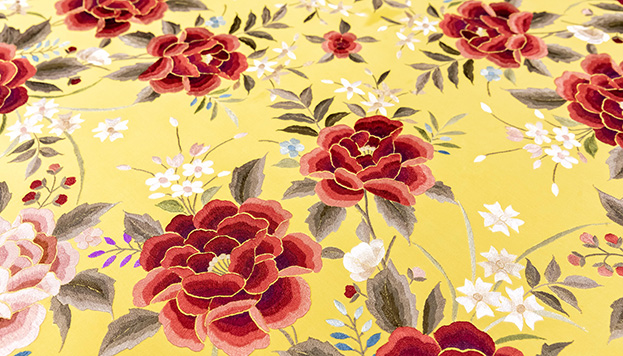
Borca. © Álvaro López del Cerro.
Only a few years before this production was staged, Benito Pérez Galdós wrote in his novel Fortunata y Jacinta: “Wrapping it around you is like wearing a painting. The modern industry will never make anything that lives up to the innocent poetry of this shawl, decorated in flowers, flowing, silky and ever so memorable, with its dream-like tangled tassels.” Yet however symbolic of the capital the shawl might be, we can’t ignore the fact that its origins couldn’t be farther away. If we listen closely enough to this summertime zarzuela this fact is hinted at in the song sung by the chorus: “To Our Lady of the Dove we’ll give a shawl from China-na, China-na, a shawl from China-na we’ll give her.”
Cultural Heritage
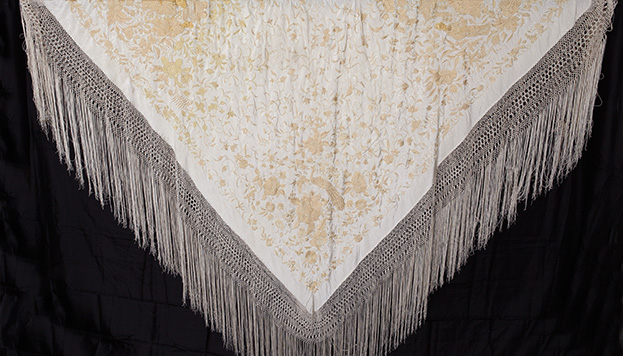
Museo Nacional del Romanticismo. © Pablo Linés Viñuales.
We have to travel back to a China ruled by the Tang dynasty, around the year 600, if we want to learn more about the origins of the Manila shawl, which owes its name to the capital of the Philippines. The archipelago was once part of the Spanish Empire and the starting point for all commercial shipping routes, meaning that all products from the East made their first stop at its ports. The Museum of Romanticism explains: “The Manila shawl can be traced back to one of the most ancient crafts of China, that of silk embroidered quilts and draperies used as decoration in the home. When these pieces were first imported to Spain, they were worn as clothing and tassels were added using twisted silk threads.” The museum itself is home to a shawl made in Canton around the year 1850, in ivory-coloured natural silk and featuring peacocks, flowers and a scene from a tea ceremony embroidered with gold silk thread. It was in the 19th century that the shawl rose in popularity among Spain’s upper-class noblewomen. However, the alluring fashion trends of the French capital soon took its place and it was then that working-class women began to drape the shawl around their shoulders at bullfights and other events.
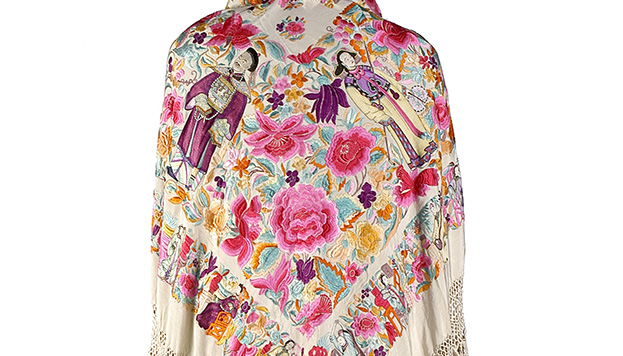
Museo del Traje, Madrid. Foto: Lucía Ybarra Zubiaga (MT016838).
The raw silk taffeta shawl on display at the Garment Museum is from the year 1900 and features Chinese flowers and figures in traditional dress decorated with dragons. We’re told that workshops in Spain began to make these shawls at the start of the 19th century, and that those that were imported from the East used to arrive in stunning lacquered boxes.
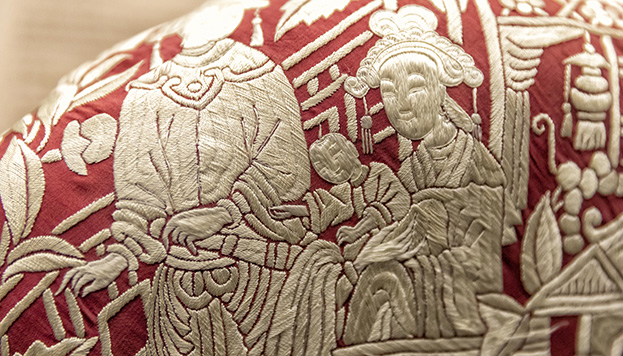
Museo Nacional de Antropología. © Álvaro López del Cerro.
At the National Anthropology Museum there’s a total of eighteen shawls. One of them is part of the museum’s permanent collection and is embroidered with flowers and birds and has long tassels. “These types of shawls,” they explain to us, “were introduced to Europe along with porcelain, brocade, silk, and ivory transported on the Manila-Acapulco Galleon, which made the crossing between the years 1565 and 1811.” The valuable collection at the National Museum of Decorative Arts also features an incredible set of historical shawls with various embroidered patterns and colours.
I’ll take it!
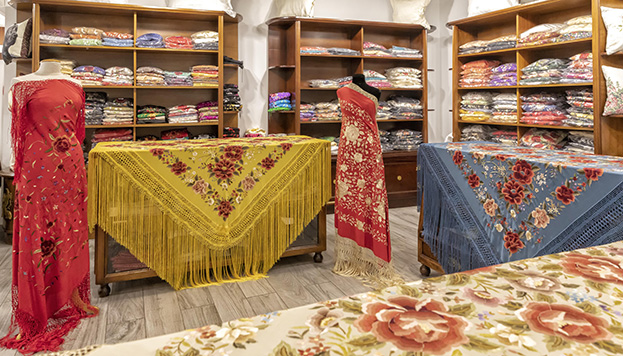
Borca. © Álvaro López del Cerro.
It’s impossible not to fall in love with this garment. And at Borca (Calle del Marqués Viudo de Pontejos, 2. Tel. 915 326 153)—a specialist store selling shawls a stone’s throw away from Plaza Mayor—they know this only too well. “Some are true gems,” we’re told, and they assure us they’re not that difficult to wear. Their advice is simple: “Don’t be afraid to give them a go.” Whether wrapped around the chest in a block shape or even in the style of dancer Juana la Macarrona, worn in a criss-cross fashion around your back with the two ends draped over your shoulders, you can wear it almost any way you like. We could spend hours and hours gazing at the various designs on display at this shop founded by Augusto Gonzalo Lázaro and his wife Consuelo, who were born in a small village in the Sierra de Gata (Cáceres). When they moved to Madrid, they first opened a shop on Gran Vía Avenue in the 1960s before opening this one, now with the third generation at its helm. They sell shawls with machine-embroidered designs, which are simpler and more affordable, as well as ones embroidered by hand, some of which are truly exquisite and come in all colours. The size of the shawl depends on the height of the wearer, although many of the larger shawls can also be used for decoration.
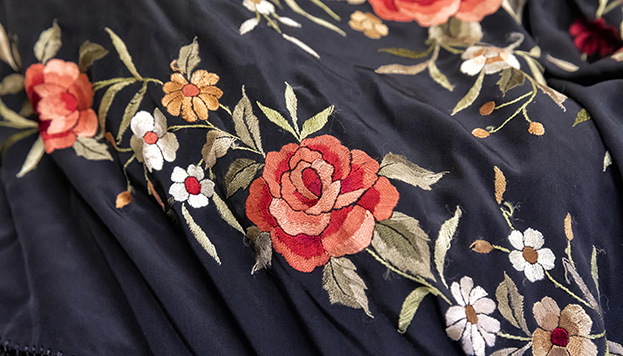
De Diego. © Álvaro López del Cerro.
Also not to be missed is the century-old Casa de Diego (Puerta del Sol, 12). This store, selling mainly umbrellas and fans, dates back to 1858 and has seen six generations behind its counter. On its shelves, not unlike those of a museum, we can spot other objects such as walking sticks, castanets and parasols, plus clothing and accessories, including Manila shawls. The square-shaped shawls are made from silk and embroidered by hand, with tassels of varying thicknesses on each of their edges. Once you’ve taken your pick and the purchase is made, it’s time to don your very own Manila shawl and head to a verbana with the confidence of a true chulapa like Susana.